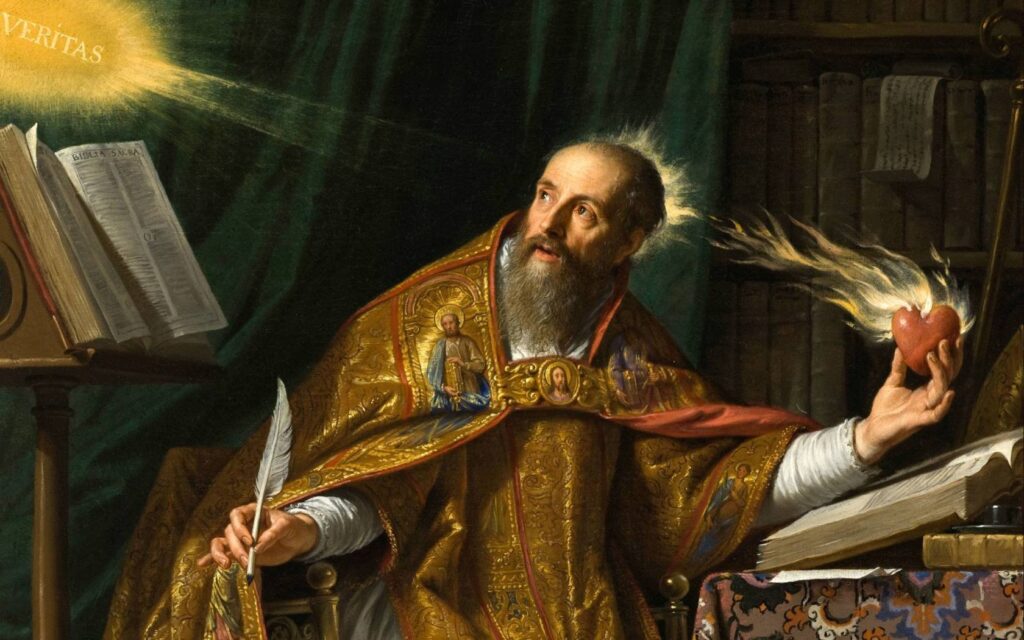Have you ever felt a restlessness gnawing at you, like a bird beating its wings against a cage, desperate for a freedom you can’t quite grasp? That was Saint Augustine for much of his life—a man who chased fleeting joys, wrestled with big questions, and rummaged through philosophies until he stumbled into God’s embrace. His journey is like a wild river: it bubbles up from the dusty plains of Roman Africa, carves through churning rapids of sin and searching, and flows into a boundless sea of grace that still laps at our shores today. For you, an American Catholic who’s ever wrestled with faith or felt a tug toward something deeper, come drift down this river with me. Let’s meet Augustine, the restless soul who became a titan of the Church, weaving faith and reason into a tapestry that lights our modern path.
The Son of Tagaste: A Boy Between Tears and Temptations
Augustine arrived on November 13, 354, in Tagaste, a humble town in Numidia (now Souk Ahras, Algeria), under the sprawling reach of the Roman Empire. His father, Patricius, was a brusque pagan landowner with a fiery streak; his mother, Monica, a steadfast Christian whose prayers rose like morning mist. Young Augustine was a sponge for knowledge—by 7, he was rattling off Latin verses and outsmarting his tutors. But he wasn’t all innocence. In his Confessions, he spills the tale of stealing pears from a neighbor’s tree as a teen—not because he was hungry, but for the sheer rush of doing wrong. “I loved my own ruin,” he confessed, a raw glimpse of a kid caught between his mother’s hopes and his own wild streak.
Monica saw the spark in him and prayed tirelessly, especially as he grew into a restless young man. At 11, he was packed off to school in Madauros, 20 miles away, where he devoured rhetoric and poetry. By 17, he hit Carthage—a bustling, gritty port city alive with temptation. There, he dove headfirst into what he’d later call “a cauldron of lust”—wine-soaked nights, women, and revelry. At 19, he started a 15-year relationship with a woman whose name he kept secret, fathering a son, Adeodato, “gift from God.” A quiet detail: even in his wandering, naming his boy hinted at a flicker of faith buried deep.
The Seeker in Shadows: A Mind Chasing False Lights
In Carthage, Augustine’s brain buzzed while his soul sagged. He joined the Manicheans, a sect peddling a neat dualism—good versus evil, light versus dark—that promised answers. For nine years, he argued their case, scribbling tracts and sparring with their leaders. But the deeper he dug, the shallower it felt. “My heart was restless, and I didn’t know why,” he’d later write, a cry that hits home for anyone who’s chased a mirage.
By his late 20s, the itch returned. In 383, at 29, he sailed to Rome, hungry for a grander arena to flex his skills as a rhetorician. A year later, he snagged a plum teaching gig in Milan, the western empire’s heartbeat. There, Neoplatonism caught his eye—a philosophy from Plotinus that pictured reality as a climb toward an infinite One. It was a lifeline: God wasn’t just a distant judge but the source of all being, and the soul could rise to Him through contemplation. It cracked his world open, but not wide enough. Then came Bishop Ambrose in Milan—his sermons weren’t dry lectures but living streams, washing over Augustine’s pride. Fun fact: Augustine first slipped into Ambrose’s Mass to critique his speaking style, only to leave rattled by the truth he heard.
Still, he teetered. He craved God but clung to his mistress, his prestige, his old habits. In a gut-punch prayer, he begged: “Lord, give me chastity and continence, but not yet.” It’s the plea of anyone stuck between wanting better and loving the mess they’re in.
The Garden of Grace: A Soul’s Surrender
Everything shifted in the summer of 386, when Augustine was 31, in a Milan garden. He’d been tangled in himself for months—Ambrose’s words, Monica’s tears, and Plotinus’s ideas swirling like a storm. One day, pacing under a fig tree, he heard a child’s voice chanting from a nearby house: “Take up and read.” It felt like heaven nudging him. He snatched up Paul’s letters, flipped them open, and landed on Romans 13:13-14: “Put on the Lord Jesus Christ, and make no provision for the flesh.” Peace crashed over him like a wave. “You touched me, and I burned for Your love,” he wrote, pinning down the blaze of that surrender.

Monica, who’d trailed him to Milan, wept with joy. On Easter 387, Ambrose baptized Augustine and Adeodato in Milan’s cathedral, water mingling with wonder. Augustine ditched his career, his lover, and his past, aiming to live as a monk back in Africa. Tragedy struck en route: Monica died in Ostia, her last breath urging him to serve God. Her loss gutted him but steeled his purpose. In Hippo (now Annaba, Algeria), he set up a modest monastery with Adeodato and pals, embracing poverty and prayer. Adeodato, brilliant like his dad, died at 17, a wound that left Augustine limping toward eternity.
The Bishop of Hippo: A Voice That Shook the Ages
In 391, Augustine’s quiet days ended. Visiting Hippo’s church, the congregation grabbed him, shouting for him to be their priest. Ordained against his will, he cried—fear and awe mixing in his tears. By 395, he was Bishop of Hippo, a post he held for 35 years. His life became a whirlwind: preaching every day, settling squabbles, and writing like his pen was on fire. His Confessions, wrapped up around 400, laid bare his soul—a poetic, gut-wrenching story of sin and salvation that still flies off shelves.
He battled heresies with ink and grit. Against the Donatists, who fractured the Church over purity, he pushed unity. Against the Pelagians, who scoffed at original sin, he championed grace, arguing we’re lost without God’s lift. His epic The City of God, sparked by Rome’s 410 fall, spans 22 books, pitting man’s fleeting city against God’s eternal one. He wrote hymns like Exsultet for Easter, and his sermons—over 8,000—poured out wisdom. In 430, as Vandals pounded Hippo’s gates, he died at 75, reciting Psalms, his monks sobbing around him.
The Doctor of Grace: Faith and Reason in Harmony
Augustine didn’t just lead—he redefined the Church’s mind, earning his crown as a Doctor of the Church. Named one of the original four in 1298 by Pope Boniface VIII, alongside Ambrose, Jerome, and Gregory, he’s the “Doctor of Grace” for a reason. His genius lay in marrying faith and reason, a dance he learned from Plotinus’s Neoplatonism. Unlike Aristotle, who’d later grip Thomas Aquinas with his focus on logic and the senses, Augustine turned inward. Plotinus taught him God was the infinite light, and the soul could know Him not just by believing, but by reasoning toward Him. “Faith seeks, reason finds,” he argued in On the Trinity, flipping the script on skeptics who saw belief as blind.
This wasn’t abstract fluff—it was revolutionary. In Confessions, he probes his own heart, showing how reason unearths God’s traces in us—memory, will, understanding mirroring the Trinity itself. He didn’t lean on Aristotle’s categories but on Plato’s echoes through Plotinus, seeing the world as a shadow of divine truth. His fights with heretics honed this: against Manicheans, he used reason to shred their dualism; against Pelagians, he proved grace trumps human effort. “Reason is faith’s partner, not its foe,” he insisted, a line that’s fueled theology for centuries. American seminaries—like Notre Dame—still wrestle with his ideas, passing them to priests who preach them Sunday after Sunday.
The Master of the Soul: Augustine’s Echo Today
Augustine didn’t need a formal canonization—his sainthood roared from the faithful the moment he died. In 1298, Boniface VIII sealed it, dubbing him a Doctor for his towering mind. His feast, August 28, fills churches with his words—words that hit hard in the U.S., where his Confessions shapes book clubs and his “restless heart” quote—“Our hearts are restless until they rest in You”—pops up on mugs and tattoos. Early missionaries brought him here; colleges like Villanova owe their brainy edge to him. Even the Founding Fathers, like Jefferson, sipped from his City of God through filtered streams, crafting ideas of justice.

Today, Augustine’s a lifeline. His dance of faith and reason speaks to a nation wrestling with doubt—science versus religion, heart versus head. Pope John Paul II hailed him as: “A father to all who seek truth” (Homily, 1986). For you, he’s a reflection: a guy who messed up, hunted for answers, and found God, proving no one’s too far gone for grace.
Chapters of a Restless Heart: Augustine’s Journey Unraveled
Let’s unroll Augustine’s life like a scroll weathered by time—each chapter a bend in the river, showing grace can tame the wildest tides. Here’s his tale in beats:
- Birth (November 13, 354): Born in Tagaste, cradled by Monica’s prayers.
- Youth in Carthage (371): Studied, sinned, and fathered Adeodato.
- Manichean Years (373): Chased their light-dark maze for answers.
- Conversion in Milan (386): Heard “Take up and read,” and gave in.
- Baptism (387): Cleansed by Ambrose, Monica beaming nearby.
- Bishop of Hippo (395): Led with voice and pen against chaos.
- Death (August 28, 430): Passed amid war, his wisdom a flame.
- Named Doctor of the Church (1298): one of the original four named by Pope Boniface VIII

I’m Jonathan Raeder, scholar of philosophy and the Catholic faith, deeply dedicated to exploring the teachings and traditions of the Church. Through years of study and reflection, I have gained a thorough understanding of Catholic philosophy, theology, and spirituality. My intention is to connect intellectual reflection with lived faith, shedding light on the richness of Catholic thought for all who wish to do so.

